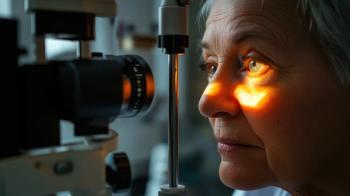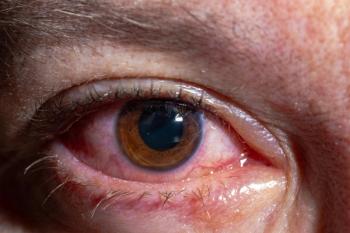
Use of, and Medicare Expenditure on, Sutureless Amniotic Membrane Grafts Soared — and Maybe Not for a Good Reason
Researchers say ophthalmologists and optometrists were motivated, at least in part, to use the sutureless grafts for dry eye disease by the profit margin they make on devices.
Despite questionable evidence about their benefit for some conditions, including dry eye disease, use of sutureless ocular amniotic membrane grafts soared from 2011 to 2020, according to
The researchers who conducted the study said that Medicare reimbursement for the grafts fueled the surge in use and associated Medicare spending because it reimbursed ophthalmologists and optometrists the wholesale acquisition cost (WAC) price for the grafts instead of what they actually paid the manufacturers. That difference, which can be as much as $600, meant a profit margin for sutureless ocular amniotic membrane grafts that in some cases exceeded what eye specialists could charge for routine cataract surgery, according to first author Daniel Vail, M.D., of the Shiley Eye Institute of the University of California, San Diego. R
Referencing an inspector general’s report, Vail and his colleagues said that many manufacturers have ignored rules requiring them to report their actual sales price instead of the WAC price, which for devices (and drugs) is just a starting point before various discounts are applied to boost sales.
“By more closely aligning tissue reimbursement with true acquisition costs for sutureless AMGs [amniotic membrane grafts], policymakers could ensure continued coverage for a medical device with established benefits and encourage ongoing research into its adoption for novel clinical indications, while also limiting the costs associated with inappropriate use of AMGs in situations where they are unlikely to benefit patients,” Vail and his colleagues wrote in the conclusion section of their study, which was published in August 2025 as an article in press.
Ushering in the sutureless era
Amniotic membrane grafts are made from the innermost layer of the placenta, or amnion. According to the American Academy of Ophthalmology, the
In Vail and his co-authors’ opinion, amniotic membrane grafts have proven clinical benefits for severe vision-threatening conditions such as Stevens-Johnson syndrome and severe burns. Their use for other indications is controversial, they say. For example, Vail and his colleagues say that some studies have found only “modest potential benefit” for their use as a treatment for bacterial keratitis and others found no clinical benefit for recurrent
But it is the use of sutureless amniotic membrane grafts as treatment for dry eye disease that has really taken off. Vail and his colleagues characterize their use as a treatment for dry eye disease as “an area of ongoing research and controversy.”
Vail and his colleagues used a 20% sample of Medicare Part B fee-for-service claims to conduct their study. They started with the claims filed for 2011, the year that the common procedural terminology code for “placement of amniotic membrane on the ocular surface without sutures” was approved, and ended in 2020, which they said was the last year that CMS data was available to them. They found 49,180 instances of the billing code for sutureless amniotic membrane grafts in that period and 23,984 unique patients.
In their sample the frequency of the grafts soared from just 319 in 2011 to 8,031 in 2020. Claims were submitted by 6,416 providers, and Vail and his colleagues found that 64 (1%) of providers accounted for 28.2% of the claims.
Vail and his colleagues also shared data showing the skyrocketing use of sutureless amniotic membrane grafts for dry eye disease. In 2011, almost 40% of the claims for the grafts were for treatment of corneal ulcers, and just 7.2% were for dry eye disease. By 2020, dry treatment accounted for 44% of the claims for the grafts.
The researchers also looked for differences between optometrists and ophthalmologists in the claims data. Uptake by optometrists was slow to start, they said, but by 2020, optometrists generated 43.3% of the claims. After factoring in age, diagnosis, sex, and comorbidities, they found that patients that were seen by an optometrist were more likely to get a sutureless amniotic membrane graft than those seen by an ophthalmologist. They also found that patients were likely to be treated with a sutureless graft within a week of meeting a provider if that provider was an optometrist.
Extrapolating the results
Vail and his co-authors extrapolated from their 20% sample to arrive at estimates of Medicare spending on the sutureless grafts. In addition to the jump from $3.6 million in 2011 to $95.6 million in 2020, they found that the allowed charges went from $1.4 million to $53.4 million. They note that those amounts are just part of what Medicare paid for the sutureless grafts because they don’t include people enrolled in Medicare Advantage plans.
Vail and his colleagues reference an inspector general’s report and a New York Times investigative story that found “pervasive clinically inappropriate use” of skin substitutes for wound care. “The use of amniotic membrane grafts in ophthalmology has not received similar attention despite relying on a similar reimbursement model,” they note. Vail and his colleagues say that the spread between the price that clinicians pay for the sutureless grafts and their reimbursement by the CMS means that clinicians are, in effect, being paid a commission by the sutureless graft suppliers.
“In an environment where the physician fee schedule has failed to keep pace with inflation, and where eye care has repeatedly been targeted with fee cuts, it is in clinicians’ best interest that policymakers reduce spending by targeting wasteful and inefficient care, rather than by implementing broad cuts in the fee schedule,” wrote Vail and his colleagues.
Newsletter
Get the latest industry news, event updates, and more from Managed healthcare Executive.





















































